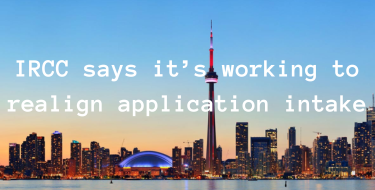IRCC says it’s working to realign application intake
As part of Immigration, Refugees, and Citizenship Canada’s (IRCC) recently unveiled strategy: An Immigration System for Canada’s Future, IRCC wants to return application processing times for major programs to service standards and re-evaluate them.
Part of this will entail matching applicant intake to available admission spots.
According to the Strategy, aligning application intake with available admissions spaces will avoid candidates from experiencing years-long delays when demand for a program exceeds available slots.
It states that by reducing wait periods through admissions intake management, applicants and their support networks will be able to better plan for their arrival, making it simpler for them to settle and integrate in Canada.
There are too many applications for certain programs.
The Parents and Grandparents Program (PGP) has a backlog of applications dating back three years to the start of the pandemic.
IRCC continued to receive PGP applications throughout the pandemic, despite border closures, travel restrictions, and the inability to process applications due to temporary office closures.
This was despite the fact that the program only provided a limited number of visas each year. According to a recent IRCC memo, there is already an inventory of approximately 100,000 people for the PGP, and IRCC is still working through the 2020 pool of candidates as of 2023.
2024-2026 Immigration Levels Plan
In its annual Immigration Levels Plan, IRCC sets immigration targets for up to three years.
The most recent plan, issued on November 1st, establishes targets for the number of permanent residents Canada intends to admit in 2024 (485,000), 2025 (500,000), and 2026 (500,000 in both years).
According to Canada’s immigration minister, Marc Miller, the current plan intends to strengthen the country’s economy and workforce through sustainable population growth. This is another factor to consider while reviewing applications.
Most permanent resident schemes, such as the PGP or the Provincial Nominee Program (PNP), have an application cap that is reflected in the Levels Plan targets.
Temporary resident programs, such as work or study permits and visitor visas, do not have an annual application limit, which can contribute to a backlog of applications and slower processing.
In response to a question about limiting the number of study permits awarded, the Minister stated that he is opposed to caps on the number of international students in Canada.
Auditor General’s Report
Adjusting application intake is one component of IRCC’s strategy to enhance processing times. It expands on a recent study by Canada’s Auditor General (OAG), which also analyzed IRCC processing times and discovered that they were frequently excessively protracted. It suggests that IRCC establish attainable and dependable service standards for all permanent residency programs.
It further suggested that IRCC analyze backlogged applications in order to identify and address processing delays under its control. It recommends that the agency prioritize the completion of older backlogged applications.
Furthermore, the Strategy states that IRCC intends to use digital technologies to help officers process requests from global offices more efficiently. According to the OAG report, modifying workload in regional offices to reflect capability will also play a role.
Finally, the IRCC Strategy states that it will boost the use of Advanced Analytics to automate some routine case assessments while ensuring that there is no built-in prejudice.
This aspect of the Strategy is already underway. IRCC said in September that it would boost the use of Advanced Analytics in the processing of Post-Graduation Work Permits (PGWPs) and Work Permit Extensions.
The tools are designed to handle “clerical and repetitive tasks” such as sorting applications by priority, perhaps making application intake easier to manage. Furthermore, these tools should allow immigration agents to dedicate more attention to petitions that are judged urgent or complex.
The current backlog
IRCC aspires to handle 80% of all applications within service standards, or the period that the department believes an application should take.
The service standard varies according on the application. Express Entry applications, for example, should take no more than six months to process, whereas family class sponsorship applications can take up to a year.
According to the most recent IRCC data, there were 2,194,900 applications in inventory as of September 30, with 928,000 considered backlog (not handled within service requirements).
This is a modest reduction from the end-of-August inventory of 2,198,000 applications.
In September, the most backlogged applications (585,700) were for temporary residence visas such as work permits, student visas, and visiting visas. The figure reflects an 18% rise over August figures.
#IRCC



